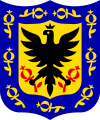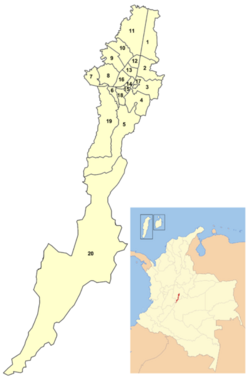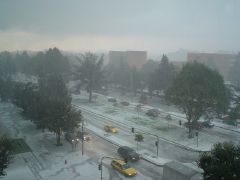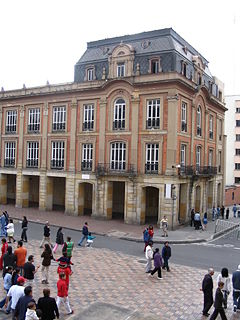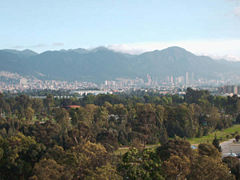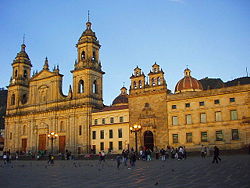Difference between revisions of "Bogota, Colombia" - New World Encyclopedia
| Line 142: | Line 142: | ||
Private universities include Los Andes University, the Javeriana University, Colegio Mayor de Nuestra Señora del Rosario, University of Bogota Jorge Tadeo Lozano, University of La Sabana, La Gran Colombia University among others while public universities include the Universidad Nacional de Colombia, Colegio Mayor de Cundinamarca, Universidad Distrital Francisco José de Caldas Universidad Militar Nueva Granada Universidad Pedagógica Nacional. <ref name="BC" /> | Private universities include Los Andes University, the Javeriana University, Colegio Mayor de Nuestra Señora del Rosario, University of Bogota Jorge Tadeo Lozano, University of La Sabana, La Gran Colombia University among others while public universities include the Universidad Nacional de Colombia, Colegio Mayor de Cundinamarca, Universidad Distrital Francisco José de Caldas Universidad Militar Nueva Granada Universidad Pedagógica Nacional. <ref name="BC" /> | ||
| − | |||
| − | ===Arts and entertainment=== | + | |
| + | ==Culture== | ||
| + | Class structure in Bogota, and in all of Columbia, is based on a mixture of occupation, wealth, and ethnicity. The “marginal” classes accounts for the vast majority of the population however they usually lack steady employment eke out a meagre living. The lower class is usually employed as physical labourers. These two groups are comprised mostly of African, American Indian, or mixed descent. The middle and upper echelons of the social structure usually perform more highly skilled work, although the middle classes lack the wealth (and perhaps the European heritage) of the upper class. The upper class is comprised of a very small group of wealthy, traditional families, almost exclusively of pure Spanish background. | ||
| + | |||
| + | Protection of one's family pride and name, collectively known as one's ''abolengo'', is extremely important to traditional Colombian elites. Family ties are critical in business and political life, and young men or women commonly follow their fathers' footsteps into business or political arenas. Elite cliques called roscas (the name of a twisted pastry) also often act behind the scenes in business and political dealings. | ||
| + | Ajicaco (a stew) is a popular lcoal food in the Bogota area.<ref name="EB1">Encyclopædia Britannica [http://www.britannica.com/eb/article-25368 Colombia] Retrieved November 10, 2007</ref> | ||
| + | |||
| + | ===Arts and entertainment=== | ||
The Teatro Libre International Jazz Festival, an internationally renowned jazz festival is held in the first week of September in Bogota each year. World class musical performances including opera, zarzuela and operetta, interpreted by Colombian and international artists occur at the Colón Theatre, the Camarín del Carmen and Colsubsidio Roberto Arias Pérez Theatre. The Philharmonic Orchestra of Bogotá performs at the National University León de Greiff Auditorium. | The Teatro Libre International Jazz Festival, an internationally renowned jazz festival is held in the first week of September in Bogota each year. World class musical performances including opera, zarzuela and operetta, interpreted by Colombian and international artists occur at the Colón Theatre, the Camarín del Carmen and Colsubsidio Roberto Arias Pérez Theatre. The Philharmonic Orchestra of Bogotá performs at the National University León de Greiff Auditorium. | ||
| − | There are approximately 80 museums in Bogota, exhibiting fine arts, contemporary and modern art, religious art and historical, archaeological, scientific and technological exhibits among others. | + | There are approximately 80 museums in Bogota, exhibiting fine arts, contemporary and modern art, religious art and historical, archaeological, scientific and technological exhibits among others.<ref name="DC">Bogotá, Colombia [http://pages.infinit.net/colombia/bogota/index.htm Bogotá DC] Retrieved November 9, 2007</ref> |
| + | |||
| + | ===Sport=== | ||
| + | The country's most widely played and watched sport in Bogota is football(soccer). Bogotá's Millonarios and Santa Fé teams have some of Columbias strongest rivalries in Columbia. The Colombian national team has also qualified for several FIFA World Cup finals and several Summer Olympic tournaments.<ref name="EB1" /> | ||
| + | |||
| + | Bullfighting, originally introduced to South America by the Spanish, remains popular in Bogota. Baseball and Basketball have also become more popular in Bogota and throughout Columbia. The only indigenous sport is tejo, a game derived from the Chibcha Indians, that is similar to quoits.<ref name="EB1" /> The object of tejo is to throw a small metal disk at a gunpowder detonator, with the winner determined by the number of explosions compared to number of throws.<ref>The Andean World [http://www.mundoandino.com/Colombia/Culture Culture of Colombia] Retrieved October 10, 2007.</ref> | ||
| + | |||
| + | ===Festivals and Fiestas=== | ||
| + | Several festivals or fiestas celebrate occurrences of local importance and are often government-subsidized and promote and preserve popular tunes and dances as well as traditional costumes. The pre-Lenten Carnival is celebrated nationally. The Bogotá Carnival (Spanish: Carnaval de Bogotá) commemorates the founding of the city, and is a combination of various cultural events including masquerades, dances, and parades and others. The Iberoamerican Theater Festival held in Bogotá every second year and is one of the largest theater festivals in the world. | ||
| − | === | + | ===Dance=== |
| − | + | Dancing is very popular throughout in Colombia, with many vibrant and popular styles. Popular dance styles include Salsa, Merengue, and Bambuco. The last one is a very complicated dance with many differently named steps. | |
| − | + | Cumbia, which originated on Columbia's Caribbean Coast, is the national dance. It should not be confussed with other kinds of Cumbia that has become popular throughout Latin America.<ref>The Andean World [http://www.mundoandino.com/Colombia/Culture Culture of Colombia] Retrieved October 10, 2007.</ref> Cumbia originated in the Caribbean coastal town of San Basilio, Colombia. Cumbia is a blend of indigenous, African and Spanish influences that originated with African slaves and indigenous cultures congregating on the moonlit beaches to dance, socialize and celebrate life.<ref>Soaring Steps [http://www.soaringsteps.org/resources/latin-american/colombian-cumbia/ Cumbia Dance History - Cumbia History ] Retrieved November 10, 2007.</ref> | |
| − | |||
| − | |||
==Infrastructure== | ==Infrastructure== | ||
| Line 160: | Line 172: | ||
] Retrieved November 9, 2007.</ref> | ] Retrieved November 9, 2007.</ref> | ||
| − | Bogota has many health centers, private clinics and state hospitals that render medical and hospital services. There are 142 public medical clinics and 22 health organizations that render services to more than 4,900,000 patients.<ref name="DC" | + | Bogota has many health centers, private clinics and state hospitals that render medical and hospital services. There are 142 public medical clinics and 22 health organizations that render services to more than 4,900,000 patients.<ref name="DC" /> |
=== Transportation === | === Transportation === | ||
Revision as of 04:40, 11 November 2007
| Bogotá | |||
| Downtown view from Colpatria Building | |||
|
|||
| Motto: Bogotá, 2600 metros más cerca de las estrellas Bogotá, 2600 meters closer to the stars |
|||
| Localities (localidades) of Bogotá | |||
| Country | Colombia | ||
|---|---|---|---|
| Department | Bogotá, D.C.* | ||
| Foundation | August 6, 1538 | ||
| Government | |||
| - Mayor | Luis Eduardo Garzón, PDA | ||
| Area | |||
| - City | 1,587 km² (612.7 sq mi) | ||
| - Land | 1,731.9 km² (668.7 sq mi) | ||
| Elevation | 2,640 m (8,661 ft) | ||
| Population (2005 census) [1] | |||
| - City | 6,778,691Ranked 1 | ||
| - Density | 3,914/km² (10,137.1/sq mi) | ||
| - Metro | 8,090,883 | ||
| *Bogotá is physically within and is the capital of Cundinamarca Department, but as the Capital District is treated as its own department. | |||
| Website: City Official Site Mayor Official Site Bogotá Tourism | |||
Bogotá—officially named Bogotá, D.C. (D.C. for "Distrito Capital", which means "Capital District"), formerly called Santa Fe de Bogotá, is the capital city of Colombia, as well as the largest and most populous city in the country, with 6,776,009 inhabitants (2005 census). Bogotá and its metropolitan area, which includes municipalities such as Chía, Cota, Soacha, Cajicá and La Calera, had an estimated population of 7,881,156 [1] according to the 2005 census.
History
Originally called by the Muiscas Bacatá meaning “planted fields”.[2] It was the center of their civilization before the Spanish explorers colonized the area, and it sustained a large population. The European settlement was founded in August 6, 1538, by Gonzalo Jiménez de Quesada and was named "Santa Fé de Bacatá" after his birthplace Santa Fé and the local name. "Bacatá" had become the modern "Bogotá" by the time it was made the capital of the New Kingdom of Granada, which was then part of the Viceroyalty of Peru, and later of the Viceroyalty of New Granada. The city soon became one of the centers of Spanish colonial power and civilization in South America.
In 1810-11 its citizens revolted against Spanish rule and set up a government of their own, but had to contend with internal divisions and the temporary return to power of Spanish military loyalists, who resumed control of the city from 1816 to 1819, when Simón Bolívar captured it after his victory at Boyacá. Bogotá was then made the capital of Gran Colombia, a federation combining the territories of modern Panama, Colombia, Venezuela, and Ecuador. When that republic was dissolved into its constituent parts, Bogotá remained the capital of New Granada, which later became the Republic of Colombia. See History of Colombia.
In 1956, the municipality was joined to other neighboring municipalities forming a "Special District" (Spanish: Distrito Especial). With the Constitution of 1991, Bogotá was confirmed as the Capital of Colombia acquiring the name "Santa Fe de Bogotá", and changing the category from Special District to "Capital District" (Spanish: Distrito Capital).
In August 2000 the capital's name was officially changed back from "Santa Fé de Bogotá" to the more usual "Bogotá". The local government consists of a Capital District, the current chief of government is Luis Eduardo Garzón.
Geography
Bogotá is located in the centre of the country, on the east of the "sabana de Bogotá", 8661 feet (2640 meters) above sea level. Although "sabana", as it is popularly called, is literally "savanna", the geographical site is actually a high plateau in the Andes mountains. The extended region is also known as "altiplano cundi-boyacense" which literally means "high plateau of Cundinamrca and Boyaca"
The Bogotá River crosses the 'sabana' forming Tequendama Falls to the south. Tributary rivers form valleys with flourishing villages, whose economy is based on agriculture, livestock raising and artisanal production.
The 'sabana' is bordered to the east by the Eastern Cordillera of the Andes mountain range. Surrounding hills, which limit city growth, run from south to north, parallel to the Guadalupe and Monserrate mountains. The western city limit is the Bogotá river; Sumapaz paramo borders the south and to the north Bogotá extends over the mentioned plateau up to the towns of Chía and Sopó.
Climate
Due to its high altitude and proximity to the equator, Bogota has a constant, mild to cool climate year 'round. Temperature fluctuations are relatively small with the average monthly high temperatures ranging from 59ºF to 62ºF (14.9ºC - 16.7ºC) while the average monthly low temperatures range from 42ºF to 48ºF(5.6ºC - 8.7ºC).[3]</ref> Dry and rainy seasons alternate throughout the year. The driest months are December to February while April, May, September, October and November are the wettest. Bogota averages 31.5 inches (799 mm) of rain per year spread over an average of 185 rain days.[3]
Frost usually occurs in dry season. During this period, the temperature falls below 0°C. The lowest temperature ever recorded was -8°C (17°F) inside the city and -10°C (14°F) in the nearby towns of the savanna.
Climatic conditions are irregular and quite variable due to the El Niño and La Niña climatic phenomena, which occur in and around the Pacific basin and are responsible for very pronounced climatic changes.
Urban Layout and Nomenclature
The urban layout dates back to Colonial times, and is a square layout adopted from Spain. The current street layout has calles which run perpendicular to the hills heading east-west with numbering increasing towards the north, and towards the south from calle 1, and carreras which run parallel to the hills in the south-north direction with numbering increasing east and west from carrera 1. New urban sectors incorporate diagonal – similar to streets – and transversal – similar to carreras. Streets are numbered.
It has over one thousand neighborhoods or divisions forming the developed urban network. Neighborhoods of higher economic status are primarily located to the north and north-east. Poorer neighborhoods are located to the south and south-east, many of them squatter areas. The middle classes usually inhabit the central, western and north-western sections of the city.
Calle = street, east-west direction. Carrera = street, north-south direction.)
Density
Governance
Bogotá is the capital of the Republic of Colombia, and houses the national legislature, the Supreme Court of Justice, and the center of the executive administration as well as the residence of the President of the Republic. The Principal Mayor and District Council are responsible for city administration and are both elected by popular vote.
The city divided into 20 localities: Usaquén, Chapinero, Santa Fe, San Cristóbal, Usme, Tunjuelito, Bosa, Kennedy, Fontibón, Engativá, Suba, Barrios Unidos, Teusaquillo, Los Mártires, Antonio Nariño, Puente Aranda, La Candelaria, Rafael Uribe Uribe, Ciudad Bolívar, Sumapáz.
Each of the 20 localities is governed by an administrative board elected by popular vote, made up of no less than seven members, as determined by the District Council. The Principal Mayor designates local mayors from a trio proposed by the respective administrative board. [4]
Economy
Bogotá is Colombia's largest economic center, followed by Medellín, Cali, and Barranquilla. Most companies in Colombia have their headquarters in Bogotá (for example, Bavaria, Avianca, Postobon, Bancolombia and Coltejer), and it is home to most foreign companies doing businesses in Colombia and neighbouring countries as well as Colombia's main stock market. Bogotá is a major center for import and export of goods for Colombia and the Andean Community in Latin America.
Manufacturing, commerce and trade
Bogotá is the hub of Colombian business. It has a busy banking, insurance sector, and a Stock exchange. Engineering firms provide services for many regions of Colombia and Central America. Bogotá houses the central governmental institutions and military headquarters. It is the centre of the telecommunications network and has the biggest industrial facilities in the country.
Some services are public and others are private. The public services include energy, sewer and phones. Energy and sewer bills are stratified based on the location of owner's residence. Thus, the wealthier sections of society help subsidize the energy bills of the poorer sections of society. Telephone service is provided by both "Empresa de Telecomunicaciones de Bogotá" (ETB), a city-owned company, and "Capitel", owned by Colombia Telecomunicaciones and "EPM Bogotá", owned in turn by the Medellín public services company (Empresas Públicas de Medellín - EPM) . Coin or card-operated payphones are also available, along with cell phone providers. There are (as of May 2007) three main operators of wireless phones: Movistar (owned by Spanish firm Telefónica), Comcel (owned by Telmex) and Tigo (co-owned by ETB, EPM and Millicom).
Bogotá also receives money from exports like flowers and emeralds. In downtown Bogotá, millions of dollars in domestically produced rough and cut emeralds are bought and sold daily. Other important industries include financial services, especially banking. Bogotá is headquarters to major commercial banks, and to the Banco de la República, Colombia's central bank. Bogotá is also a printing and publishing centre. The city is a major convention destination with many major convention centres: Centro Ferial de Convenciones Corferias, Centro de Convenciones y Eventos Cafam, Centro de Convenciones Gonzalo Jiménez de Quesada, among others. Because of its status as site of the country's capital, it is home to a number of government agencies, which represent another major component of the city's economy.
The city's industrial base include staples of the Colombian economy such as GM Colmotores, Compañía Colombiana Automotriz, and Ecopetrol.
Demographics
The largest and most populous city in Colombia, Bogotá has 7,881,156 inhabitants in its metropolitan area (2005 census).
As with Colombia as a whole, the vast bulk of the city's population consists of mestizos (those of mixed Indian and white European descent) and those of white European descent. However, there is a lesser number of residents of African descent than in the country as whole given the city's distance from coastal areas such as Cartagena, where the descendants of African slaves have traditionally resided.
Crime
In the 1990's, Bogotá was considered one of the most dangerous cities in the world. At one point it had a homicide rate of 80 per 100,000. Since then, however, Bogotá has gone to great lengths to change its crime rate and its image. The change was the result of a participatory and integrated security policy that was first adopted in 1995. Because of its success, this security policy has continued to be implemented ever since. In 2005, Bogotá had a murder rate of 23 persons per 100,000 inhabitants, a 71% drop from what it had 10 years ago. Interestingly, by the way of comparison, the city today has a lower murder rate than Washington, D.C., Caracas, São Paulo, Mexico City, Panama City, and Rio de Janeiro.[5][6]
Education

The District Education Department is the entity responsible for preschool, primary, secondary and middle education in Bogota. According to article 67 of the Colombian Political Constitution, "the State, society and family are responsible for education, that will be obligatory between 5 and 15 years of age and that will consist of minimum one preschool year and nine years of Basic education". The "Bogotá, a Great School" plan guarantees a total coverage of educational needs so that the education systemis available to all children in the education years.[7]
Bogota has many public and private schools, universities, technical Institutes, language schools, etc. Bogotá's colleges and universities have a major impact on the city and region's economy. Not only are they major employers, but they also attract national and international industries to the city and surrounding region, including highly needed technology industries. The city is Colombia's educational hub.
Private universities include Los Andes University, the Javeriana University, Colegio Mayor de Nuestra Señora del Rosario, University of Bogota Jorge Tadeo Lozano, University of La Sabana, La Gran Colombia University among others while public universities include the Universidad Nacional de Colombia, Colegio Mayor de Cundinamarca, Universidad Distrital Francisco José de Caldas Universidad Militar Nueva Granada Universidad Pedagógica Nacional. [8]
Culture
Class structure in Bogota, and in all of Columbia, is based on a mixture of occupation, wealth, and ethnicity. The “marginal” classes accounts for the vast majority of the population however they usually lack steady employment eke out a meagre living. The lower class is usually employed as physical labourers. These two groups are comprised mostly of African, American Indian, or mixed descent. The middle and upper echelons of the social structure usually perform more highly skilled work, although the middle classes lack the wealth (and perhaps the European heritage) of the upper class. The upper class is comprised of a very small group of wealthy, traditional families, almost exclusively of pure Spanish background.
Protection of one's family pride and name, collectively known as one's abolengo, is extremely important to traditional Colombian elites. Family ties are critical in business and political life, and young men or women commonly follow their fathers' footsteps into business or political arenas. Elite cliques called roscas (the name of a twisted pastry) also often act behind the scenes in business and political dealings. Ajicaco (a stew) is a popular lcoal food in the Bogota area.[9]
Arts and entertainment
The Teatro Libre International Jazz Festival, an internationally renowned jazz festival is held in the first week of September in Bogota each year. World class musical performances including opera, zarzuela and operetta, interpreted by Colombian and international artists occur at the Colón Theatre, the Camarín del Carmen and Colsubsidio Roberto Arias Pérez Theatre. The Philharmonic Orchestra of Bogotá performs at the National University León de Greiff Auditorium.
There are approximately 80 museums in Bogota, exhibiting fine arts, contemporary and modern art, religious art and historical, archaeological, scientific and technological exhibits among others.[10]
Sport
The country's most widely played and watched sport in Bogota is football(soccer). Bogotá's Millonarios and Santa Fé teams have some of Columbias strongest rivalries in Columbia. The Colombian national team has also qualified for several FIFA World Cup finals and several Summer Olympic tournaments.[9]
Bullfighting, originally introduced to South America by the Spanish, remains popular in Bogota. Baseball and Basketball have also become more popular in Bogota and throughout Columbia. The only indigenous sport is tejo, a game derived from the Chibcha Indians, that is similar to quoits.[9] The object of tejo is to throw a small metal disk at a gunpowder detonator, with the winner determined by the number of explosions compared to number of throws.[11]
Festivals and Fiestas
Several festivals or fiestas celebrate occurrences of local importance and are often government-subsidized and promote and preserve popular tunes and dances as well as traditional costumes. The pre-Lenten Carnival is celebrated nationally. The Bogotá Carnival (Spanish: Carnaval de Bogotá) commemorates the founding of the city, and is a combination of various cultural events including masquerades, dances, and parades and others. The Iberoamerican Theater Festival held in Bogotá every second year and is one of the largest theater festivals in the world.
Dance
Dancing is very popular throughout in Colombia, with many vibrant and popular styles. Popular dance styles include Salsa, Merengue, and Bambuco. The last one is a very complicated dance with many differently named steps. Cumbia, which originated on Columbia's Caribbean Coast, is the national dance. It should not be confussed with other kinds of Cumbia that has become popular throughout Latin America.[12] Cumbia originated in the Caribbean coastal town of San Basilio, Colombia. Cumbia is a blend of indigenous, African and Spanish influences that originated with African slaves and indigenous cultures congregating on the moonlit beaches to dance, socialize and celebrate life.[13]
Infrastructure
Health
Health services in Bogota are administered by the District Department of Health and funded by a contribution of 4% of all employees income. Non-employed persons are covered under a subsidized health regime, in which the contribution depends on the income level.[14]
Bogota has many health centers, private clinics and state hospitals that render medical and hospital services. There are 142 public medical clinics and 22 health organizations that render services to more than 4,900,000 patients.[10]
Transportation
Bogotá has an extensive modern transportation system comprising in excess of 15,000 buses, busetas (medium size buses), colectivos (vans or minivans), taxis and the Transmilenio (92 articulated buses implemented in 2001). Buses are the main means of mass transportation. Bogotá is also a hub for national and international bus routes with the main terminal serving routes to the majority of cities and towns in Colombia [15] international services to Ecuador and Venezuela.
Bogotá's main airport, Aeropuerto Internacional El Dorado, handles all domestic and international flights.[16] In 2007 a major expansion was started that will expand the airport's capacity from the current 8 million passengers per year to 16 million passengers per year. A smaller airport, Guaymaral Airport, serves as a base for Police Aviation and all general aviation activities.
In an attempt to reduce the traffic congestion caused by the one millon plus vehicles on the streets Bogota intorduced a vehicle restriction rule called 'pico y placa' that applies to all vehicles, public and private. Pico y Placa restricts driving to certain days of the week, according to the license plate number.[17]
Bogotá has an extensive network of dedicated bike paths, also called ciclo-rutas. It is estimated that more than 182,000 people daily use the bicycle as a mode of transportation.[18]
Flag
The flag originates from the insurgency movement against the colonial authorities, which began on July 20, 1810. During this insurgency, the rebels wore armbands with yellow and red bands, as these colours were the ones in the Spanish flag which was the one used as the flag for the New Kingdom of Granada.
In October 9, 1952, exactly 142 years after these events, decree 555 of 1952 officially and definitively adopted the patriotic armband as the flag of Bogotá.
The flag itself is divided horizontally in two, the top band is yellow and the bottom band is red. The yellow colour denotes the gold from the earth, as well as the virtues of justice, clemency, benevolence, the so-called "mundane qualities" (defined as nobility, excellence, richness, generosity, splendour, health, steadfastness, joy and prosperity), long life, eternity, power and constancy. The red colour denotes the virtue of charity, as well as the qualities of bravery, nobility, values, audacity, victory, honour and furor, Colombians call it the blood of their people.
Coat of arms
The coat of arms of the city was granted by emperor Charles V (Charles I of Spain) to the New Kingdom of Granada, by royal decree given in Valladolid, Spain on December 3, 1548. It contains a black eagle in the center, which symbolises steadfastness. The eagle is also a symbol of the Habsburgs, which was the ruling family of the Spanish empire at the time. The eagle is crowned with gold and holds a red pomegranate inside a golden background. The border contains olive branches with nine golden pomegranates in a blue background. The two red pomegranates symbolize audacity, and the nine golden ones represent the nine states which constituted the New Kingdom of Granada at the time.
In 1932 the coat of arms was officially recognized and adopted as the symbol of Bogotá.
Anthem
The lyrics to the anthem of Bogotá were written by Pedro Medina Avendaño, the melody was composed by Roberto Pineda Duque. The song was officially declared the anthem by decree 1000 of July 31, 1974, by then Mayor of Bogotá, Aníbal Fernandez de Soto.
Parks and recreation
- There are many parks and most of them have facilities for concerts, plays, movies, storytellers and other activities. "Simón Bolívar Metropolitan Park", for instance, is a big park which is regularly used to stage free concerts (such as the annual Rock al Parque, a free festival in which new and popular Latin rock bands play for free). The park is also frequented in the month of August and used for kite flying, a national tradition. The whole complex is five times bigger than central park.
- Another public park is Parque Nacional (National Park), one of the biggest in Bogotá. The park has many trees and green spaces, as well as ponds, games for children, many foot and bicycle paths, and venues for entertainment such as public screenings of movies and concerts and events organized by the Council of Bogotá. It is located between two main streets, the Circunvalar Avenue and the 7th Avenue.
- The Bogotá Botanical Garden (Jardín Botánico de Bogotá).
- There are many other parks around the city of Bogotá. Each neighborhood has its own park. Some of these parks are private and others are public. Some private parks demand that people from the neighborhood have a card to be able to get into the park. Public parks are for everybody. Some of them have watchmen. These parks also have sporting venues, which provide sports programs for children and adults, such as volleyball, basketball, taekwondo, football, and other sports.
- The most active park (in both leisure activity, promotion of high-end products and nightlife) is the "Parque de la 93" located between 93rd and 93Ath street, and 12th and 13th avenue. Several of the top restaurants and bars in the city are located in this park or in the vicinity of a "T" shaped pedestrian strip dubbed "La T" (The T) in the intersection of 82nd street and Cra.12. More recently, restaurant activity has begun in the "Zona G" (Gourmet Zone) in and around 67th and 70th Streets, as well as other locations like Usaquen (north-east), and La Macarena (center east).
- Bogotá has not only natural parks but also amusement parks like Mundo Aventura and Salitre Mágico. There is a special rate to get into these parks and people have to buy tickets to be able to play mechanical games. Mundo Aventura park has mechanical games such as sky-coaster, roller coaster, hammer, and other adult amusements. For children there are some mechanical games like little roller coaster, carousel, turtles, and so on. In this park, people can find both amusements and nature, with animals such as goats for children to feed. Besides, there is a "Cerdodromo", which is a place where pigs race.
- The other amusement park is "Salitre Mágico", which is one of the entertainment centers for children and adults. The are many mechanical games like pirate ship, apocalypse, 3 roller coasters and other games. The park is next to the Simón Bolívar park, which is a well known place in Bogotá (used also for concerts through the year).
- For relaxing and finding peace from the stress of city life, the Parque del Chicó, with trees, gardens, artificial creeks and ponds, and a colonial style house converted into a museum, is worth a visit.
- Not so far from the city, up north, the Parque Jaime Duque offers a cultural encounter for visiting families. It has rides, a giant map of Colombia, popular exhibits, and a zoo. A big hand holding the world symbolizes God, and a reproduction of the Taj Mahal provides a picture collection with reproductions of famous paintings.
- Bogotá has an interactive museum of sciences called Maloka.
- Bogotá has seen concerts of important international artist like Alanis Morissette, Angra, Black Eyed Peas, Dream Theater, Jamiroquai, Jon Bon Jovi, Guns n' roses, Gwen Stefani, Helloween, Metallica, Marilyn Manson and Therion .
Sister cities
 Tokyo, Japan
Tokyo, Japan Los Angeles, California
Los Angeles, California Buenos Aires, Argentina
Buenos Aires, Argentina London, United Kingdom
London, United Kingdom Madrid, Spain
Madrid, Spain Mexico City, Mexico
Mexico City, Mexico Miami, Florida
Miami, Florida Seoul, South Korea
Seoul, South Korea New York City
New York City Ottawa, Canada
Ottawa, Canada
Trivia
- Bogotá hosts the Iberoamerican Theater Festival, the biggest theater festival in the world, every two years.
- In 2007, Bogotá is the Book Capital of the World
- The city also celebrates the International Book Fair, one of the three major book fairs of the Spanish-speaking Americas.
- The tallest building in the city is the Colpatria Tower.
- The former motto of the city was "2600 metres closer to the stars" (in reference to its altitude above sea level).
- The city has institutionalized a day without cars on the streets, called "El Día sin Carro" (No car day). It takes place every first Thursday of February. See Car Free Days and United Nations Car Free Days.
- Bogotá has the highest quality as well as the most expensive potable water in Latin America.
- The Capital District as a whole has the largest economy in Colombia and ranks eighth in Latin America.
- The Gold Museum has the biggest gold handicraft collection in the world.
- Bogotá has one of the most extensive dedicated Bike Paths Network of any city in the world, with a total of 300km.
ReferencesISBN links support NWE through referral fees
- ↑ DANE, Censo General 2005 Resultados Area Metropolitana de Bogotá
- ↑ Arias, S. and Meléndez, M. (2002). "Sacred and Imperial Topographies in Juan de Castellanos's Elegías de varones ilustres de Indias", Mapping Colonial Spanish America: Places and Commonplaces of Identity, Culture and Experience. Bucknell University Press. ISBN 0838755097.
- ↑ 3.0 3.1 World Weather Information ServiceBogota, ColumbiaRetrieved November 9, 2007
- ↑ Official Website of Bogota Tourism Government and Administration Retrieved November 7, 2007
- ↑ 2005 Washington, DC Murder Rate Infoplease.com
- ↑ Profiling Bogotá's Security Plan, Comunidad Segura.
- ↑ Bogota City Hall Education Retrieved November 10, 2007.
- ↑ Cite error: Invalid
<ref>tag; no text was provided for refs namedBC - ↑ 9.0 9.1 9.2 Encyclopædia Britannica Colombia Retrieved November 10, 2007
- ↑ 10.0 10.1 Bogotá, Colombia Bogotá DC Retrieved November 9, 2007
- ↑ The Andean World Culture of Colombia Retrieved October 10, 2007.
- ↑ The Andean World Culture of Colombia Retrieved October 10, 2007.
- ↑ Soaring Steps Cumbia Dance History - Cumbia History Retrieved November 10, 2007.
- ↑ Bogotá City Hall [http://www.bogota.gov.co/portel/libreria/php/decide.php?patron=01.180304 Bogotá Health Services ] Retrieved November 9, 2007.
- ↑ Bogotá Transportation Terminal & Train Station Bogota-dc.com
- ↑ Transport Retrieved November 9, 2007.
- ↑ Transport Retrieved November 9, 2007.
- ↑ SECRETARY OF MOBILITY - Bogota D.C. Bogota on BicycleRetrieved November 9, 2007.
Panorama van bogota.jpg |1000px|
External links
- Travel guide to Bogota, Colombia from Wikitravel
- City Official Site
- Mayor Official Site
- Bogotá Tourism Guide
- Skyscrapers and Buildings in Bogotá - Photographies and general information about buildings in the city.
- Bogotá Tourism - Directory & travel information
- BogoWiki - A Wiki dedicated to Bogotá
- Hostels in Bogotá
- Bogotá from The Air - Aerial photographs of Bogotá
- Museos de Bogotá - A museum guide for the Colombian capital
- Harvard Gazette Archives Text on Antanas Mockus's many inspired strategies to change Bogotá
Credits
New World Encyclopedia writers and editors rewrote and completed the Wikipedia article in accordance with New World Encyclopedia standards. This article abides by terms of the Creative Commons CC-by-sa 3.0 License (CC-by-sa), which may be used and disseminated with proper attribution. Credit is due under the terms of this license that can reference both the New World Encyclopedia contributors and the selfless volunteer contributors of the Wikimedia Foundation. To cite this article click here for a list of acceptable citing formats.The history of earlier contributions by wikipedians is accessible to researchers here:
The history of this article since it was imported to New World Encyclopedia:
Note: Some restrictions may apply to use of individual images which are separately licensed.
